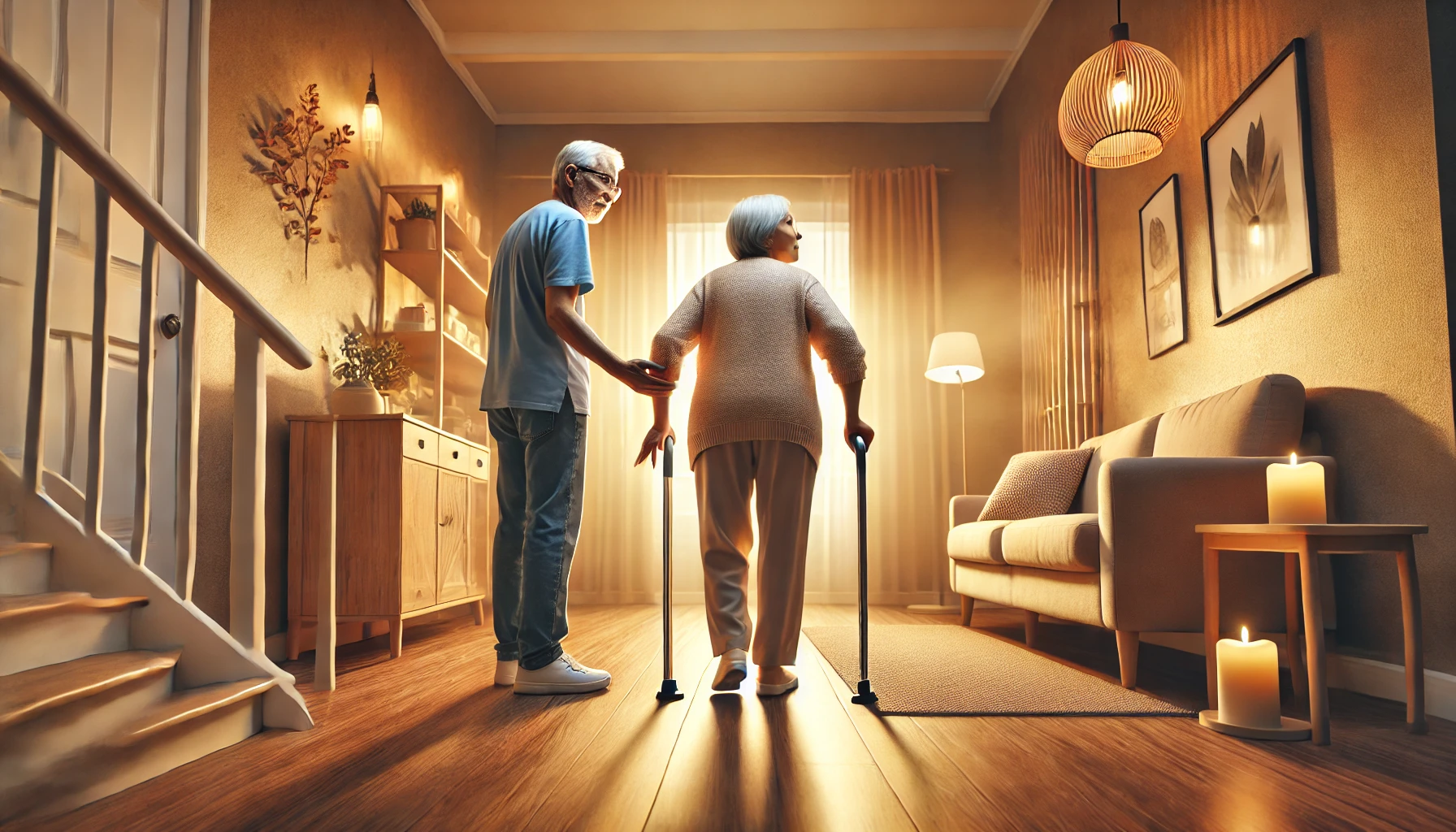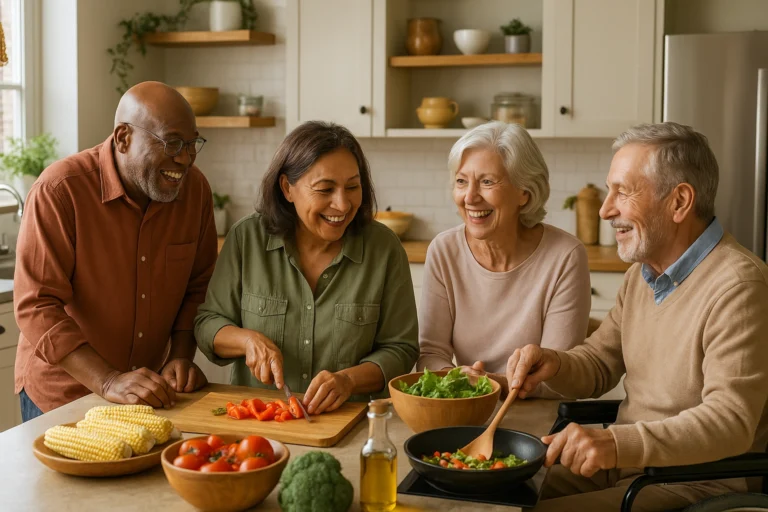As caregivers, our role is pivotal in ensuring the safety and well-being of seniors. With age often comes increased vulnerability to accidents and health issues. Therefore, being aware of the specific challenges our loved ones may face can vastly improve their quality of life. Providing effective caregiving means equipping ourselves with essential senior safety advice that goes beyond basic knowledge. It requires us to actively engage with their needs, from daily routines to mobility assistance.
In this article, we will delve into key areas that every caregiver should prioritize for effective caregiving. We’ll explore vital topics such as meal preparation safety, fall prevention strategies, medication management, and living environment modifications designed to promote independence while minimizing risks. By understanding these critical aspects of senior care, you can foster a safe living space where your elderly loved ones can thrive confidently within their own homes. Join us as we uncover practical caregiver tips that empower not just the seniors we care for but also the dedicated individuals walking alongside them on this journey towards safer aging.
Meal Preparation Safety for Seniors and Caregivers
Ensuring the safety of seniors in the kitchen is a key responsibility for caregivers. Kitchen accidents can lead to serious injuries, making it crucial to implement strategies that reduce these risks. For instance, placing non-slip mats near sinks and cooking areas can help prevent slips and falls. Additionally, caregivers should keep sharp objects like knives stored safely out of reach or utilize specialized utensils designed for ease of use by those with limited dexterity. Simple modifications such as using lighter cookware can also lessen strain while lifting pots or pans.
Safe food storage practices are essential for maintaining both the health and safety of seniors. It’s important to regularly check expiration dates on perishable items and ensure that food is stored at appropriate temperatures to avoid any risk of foodborne illnesses. Labeling containers with clear and large print helps seniors identify items quickly, minimizing confusion when preparing meals. A freezer inventory list can provide an extra layer of organization, ensuring that frozen goods aren’t forgotten or consumed past their safe limits.
Dietary considerations play a significant role in senior health, making it imperative for caregivers to prioritize nutrition during meal preparation. A diet rich in fruits, vegetables, whole grains, and lean proteins supports overall wellness and helps manage chronic conditions common among the elderly. Caregivers should also consider any dietary restrictions such as low sodium or sugar-free options based on individual health needs. By involving seniors in meal planning—like discussing favorite foods or preferences—caregivers can foster a sense of autonomy while promoting healthy eating habits that contribute positively to their well-being.
Creating a safe kitchen environment not only enhances senior safety but also encourages independence during meal times. By investing time into understanding personalized dietary needs and implementing practical safety measures, caregivers can make a significant difference in the daily lives of seniors they support.
Fall Prevention Strategies for Seniors and Caregivers
Falls are among the leading causes of injury for seniors, making it crucial for caregivers to understand common risks and take proactive measures. Many falls occur due to slippery surfaces, loose rugs, or cluttered walkways in the home. Caregivers should encourage seniors to keep pathways clear of obstacles and ensure that carpets are secured with non-slip backing. Moreover, visibility plays a significant role; aging can affect eyesight, so dimly lit spaces can become hazardous. Simple solutions such as adding nightlights in hallways and ensuring all areas are well-lit can dramatically reduce the chances of an unfortunate event.
In addition to clearing clutter and improving lighting, modifying the living environment is essential for enhancing safety. Bathrooms are high-risk areas for falls, so installing grab bars near toilets and showers can provide extra support for seniors navigating these slippery spaces. Grab bars should be placed strategically in areas where seniors may need assistance with balance, offering them much-needed stability. Lowering the height of beds or providing a bed rail can also help prevent falls during transfers from sitting to standing. These small renovations not only promote independence but also create an environment where seniors feel more secure moving about their homes.
Assistive devices, such as walkers, canes, and even stability belts, also play an invaluable role in reducing fall risk. These items provide physical support while encouraging mobility. It’s important for caregivers to educate themselves on how to properly fit and utilize these aids so that seniors benefit maximally while feeling empowered, not restricted. Additionally, technology has advanced significantly in this area. Tools such as fall detection devices can alert emergency contacts if a senior falls, providing both seniors and their families with peace of mind.
By focusing on understanding fall risks and implementing practical modifications, such as grab bars and assistive devices, caregivers create a safer atmosphere that promotes confidence in mobility. This approach fosters a sense of control over their environment, which is vital for maintaining dignity and independence as seniors age.
Mobility Assistance and Safety Tips for Seniors and Caregivers

Maintaining mobility is essential for seniors, not only for physical health but also for mental well-being. As caregivers, understanding the best practices for providing mobility assistance can make a significant difference in a senior’s daily life. One effective technique is to promote regular movement throughout the day instead of long periods of inactivity. Encourage simple activities such as short walks around the house or gentle stretching exercises in their chair. Not only do these activities help maintain strength and flexibility, but they also foster a sense of accomplishment and independence.
Adapting the home environment is crucial to enhancing mobility for seniors. Carefully assess common pathways and areas that might pose challenges, such as tight corners or steps. Consider rearranging furniture to create wider walkways, removing throw rugs that could cause tripping hazards, and ensuring that frequently used items are stored within easy reach. Installing grab bars in hallways and bathrooms, and using non-slip mats can also encourage safer movement throughout the home. If space allows, creating “rest stations” with comfortable seating can provide seniors with places to pause during longer journeys across their living space.
While safety is paramount, fostering an atmosphere where seniors feel empowered to move independently aids both their confidence and overall quality of life. Let them take charge by offering choices in how they get around—perhaps using a walker one day or opting for arm support another time. Encourage them to set small goals related to mobility that align with their comfort level; perhaps aiming to walk down the hallway unassisted before tackling outdoor outings. This supportive approach reinforces their autonomy while ensuring safe navigation through assisted techniques when necessary.
In conclusion, helping seniors maintain mobility safely encompasses both practical adjustments at home and encouraging an empowering mindset. By implementing these strategies and focusing on individual needs, caregivers play a pivotal role in promoting not just mobility but overall senior safety within their living environments. Being attentive to these aspects fosters independence while ensuring comprehensive support when needed most.
Home Safety Tips for Caregivers of Seniors
Creating a safe, accessible living environment is essential for preventing accidents among seniors with mobility or cognitive challenges. One of the easiest modifications caregivers can make is decluttering. Clear pathways without obstacles like loose rugs, cords, or clutter reduce fall risks and make moving around easier. Ensuring frequently used items, such as kitchen supplies or personal belongings, are within reach can also enhance a senior’s comfort and sense of independence.
Proper lighting is another key safety measure. Many falls happen due to poor visibility during early morning or evening hours. Adding bright LED lights along hallways and stairways, as well as motion-sensor lights near entryways and bathrooms, ensures good illumination without searching for switches. Adjustable lamps with easy-to-reach controls allow seniors to manage lighting based on their preferences throughout the day.
Furniture placement contributes to a safer and more inviting space. Lower-profile furniture with rounded edges minimizes injury risk if a fall occurs. Placing chairs with armrests in common areas helps seniors sit and stand more confidently, providing extra stability. Securing rugs with non-slip materials and using clear mats at entrances also reduces hazards from wet conditions.
Technology can further enhance home safety. Smart devices like voice-activated assistants allow caregivers to monitor unusual activity patterns, and wearable emergency response systems let seniors call for help at the push of a button. Thoughtful modifications and supportive technology allow caregivers to create a safe environment that supports seniors’ independence and well-being at home.
Medication Safety Tips for Caregivers of Seniors
Effective medication management is essential to senior safety. With the number of prescriptions and over-the-counter medications seniors often take, creating a clear organization system is crucial for reducing errors. Using pill organizers that sort medications by day and time helps ensure correct doses are taken as scheduled. Clearly labeled sections and an up-to-date list of medications also assist caregivers and seniors in tracking doses.
Monitoring for signs of medication misuse or confusion is also key. Caregivers should watch for changes in behavior, such as forgetfulness, drowsiness, or agitation, which may indicate medication issues. If a senior becomes unusually withdrawn after starting a new prescription, this might signal an adverse reaction or dosage issue. Regular check-ins to discuss how they feel about medications can help identify any concerns early.
Effective communication with healthcare providers is vital in medication management. Caregivers benefit from open discussions with doctors and pharmacists to ensure accurate dosages and avoid interactions. Attending medical appointments or preparing notes for telehealth consultations allows caregivers to ask questions and address any concerns.
Incorporating these practices into daily routines promotes safer medication management and empowers seniors to stay engaged in their healthcare. Collaborative efforts create an environment focused on safety, tailored to each senior’s needs.
Senior Kitchen Safety Tips for Caregivers
The kitchen, often the heart of the home, can pose hazards for seniors. Caregivers should address risks like slip-and-fall incidents from spills or crowded spaces, as well as dangers from knives and hot surfaces. Regularly checking for loose rugs or mats greatly reduces tripping hazards. Storing utensils and tools within easy reach prevents seniors from stretching or climbing to access them.
Caregivers can also simplify appliance use by ensuring clear, visible labels on device settings. For complex gadgets like food processors or microwaves, opt for models with preset buttons rather than complex options. Encourage seniors to use grip-enhancing oven mitts to prevent burns while handling hot cookware.
Creating a user-friendly kitchen goes beyond appliances. Arrange pots, pans, and ingredients to minimize excess movement. Store frequently used items at waist level to reduce fall risk associated with bending or reaching. Adding non-slip mats around work areas and ensuring bright lighting reduces hazards from shadows or dim corners.
Encourage seniors to use adaptive cooking techniques, which can enhance safety and foster independence. Lightweight tools and ergonomic utensils, like jar openers, minimize joint strain. By creating a supportive kitchen environment, caregivers can boost safety while promoting confidence and enjoyment in cooking.
Senior Safety Tips for Caregivers: Daily Routines That Enhance Safety
Establishing consistent schedules is essential for senior safety and well-being. Routine gives structure, reducing confusion and anxiety. Regular mealtimes ensure good nutrition and prevent blood sugar dips, which can reduce risks of disorientation or falls. Caregivers can tailor routines to include essential activities like bathing, exercise, and leisure, enhancing both mood and cognitive function.
Adding safety checks to daily routines further promotes safety. Actions like checking walkways for clutter each morning or testing smoke detectors weekly can greatly improve a senior’s environment. During these checks, caregivers might find hazards, such as loose rugs or poor lighting, that pose risks. Combining these assessments with other routines helps caregivers catch issues early.
Involving seniors in their care plans boosts adherence to safety precautions. Encourage them to choose the best times for activities or their preferred foods. This approach respects their preferences, promoting autonomy. For example, let them help plan grocery lists or select comfortable exercises, which increases engagement in their health journey. This also helps caregivers better understand seniors’ unique needs, improving outcomes.
Prioritizing daily routines allows caregivers to create a secure, supportive environment. Routine evaluations of home safety and active participation in daily life provide seniors with stability and independence.
Senior Safety Tips for Caregivers: Strategies to Promote Independence
When caring for seniors, promoting independence isn’t just about allowing choices; it’s about empowering them with tools tailored to their needs. Using items like dressing aids or specially-designed kitchen tools can help seniors manage daily tasks without heavy reliance on caregivers. Simple adjustments, like using a long-handled reacher or ergonomic jar opener, can boost seniors’ confidence to handle personal care and meal preparation on their own.
Creating a respectful environment that values senior input is crucial for fostering independence. Involve them in decisions about preferences and abilities to build their self-esteem. For example, let them pick from a few clothing or meal options rather than deciding everything for them. This approach not only fosters autonomy but makes them feel valued. Family meetings or casual chats where seniors can share thoughts on their routines help caregivers customize their approach based on what seniors truly need.
Building a support network in the community also enhances seniors’ independence. Connecting with local programs for resources like meal deliveries, companionship services, or transport helps seniors feel less isolated. This also lets them retain some control over their lives. Participating in community activities gives essential social support, which is key for mental health. Caregivers can research options and help seniors join groups that align with their interests, like gardening clubs, gentle exercise classes, or art workshops.
In summary, promoting independence as a caregiver means more than giving freedom. It includes using tools for self-sufficiency, respecting senior opinions in decision-making, and connecting them with community resources. This approach ensures caregivers support autonomy as well as provide help when needed.
Wrapping Up: The Importance of Senior Safety
In conclusion, the safety of seniors is a responsibility that caregivers should prioritize every day. From meal preparation safety to effective medication management, incorporating essential senior safety advice into daily routines can greatly enhance a senior’s quality of life. Implementing fall prevention strategies and making thoughtful living environment modifications are just a few caregiver tips that ensure a safe space for our loved ones.
As needs change, it’s critical to adapt caregiving strategies accordingly. Foster independence while providing necessary support; this empowers seniors and promotes their self-sufficiency. Remember, you play an essential role in creating a secure environment where seniors can thrive. By staying informed and proactive, you’ll contribute significantly to their well-being and health. Check out SeniorThrive for more!



